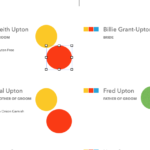Catering is hard enough without having to do full sit-down plated, multi choice service. We have all done it. And, unfortunately, it can be a bear to keep track of all the allergies and choices.
A few years ago, I had the opportunity to do the food for a relationship conference. It was a challenge, but it was really rewarding. The hardest part of the planning was figuring out how to deal with the dinners to mesh with the theme, and to make sure the one banquette sit-down went off well.
I came up with a way to let the servers know what plate could go where. Using business card blanks, we created place cards for everyone, plus a few because there are always late registrants, that were colorful and did not distract from the presentation of the food while the guests were socializing.
The number of choices were confirmed. The allergies and substitutions were collated. The colors that the event coordinators were using were sampled. And then the process of making the cards took just about three hours in the beginning, with a few tweaks here and there when changes were presented.
The people had their cards in the information packet at the registration desk at the beginning of the conference. That had it’s own problems, but it was not assigned seating, so everyone could put their cards down at their place and then go and socialize. We had the opportunity to put the plates down where they were supposed to go with little fun and most of it worked out well.
Using the pre-cut cards for printers such an easy way to go, and a form factor that people usually understand. With weddings, you can use motifs that go with the theme, and colors that the bridal party are wearing, without it being too obvious. It can be as formal or informal as you need it to be, while keeping the food count and portion control in check.
It is recreating and simplifying the methods of food service that fascinate me the most. Cooking is only one aspect of the whole hospitality industry.

